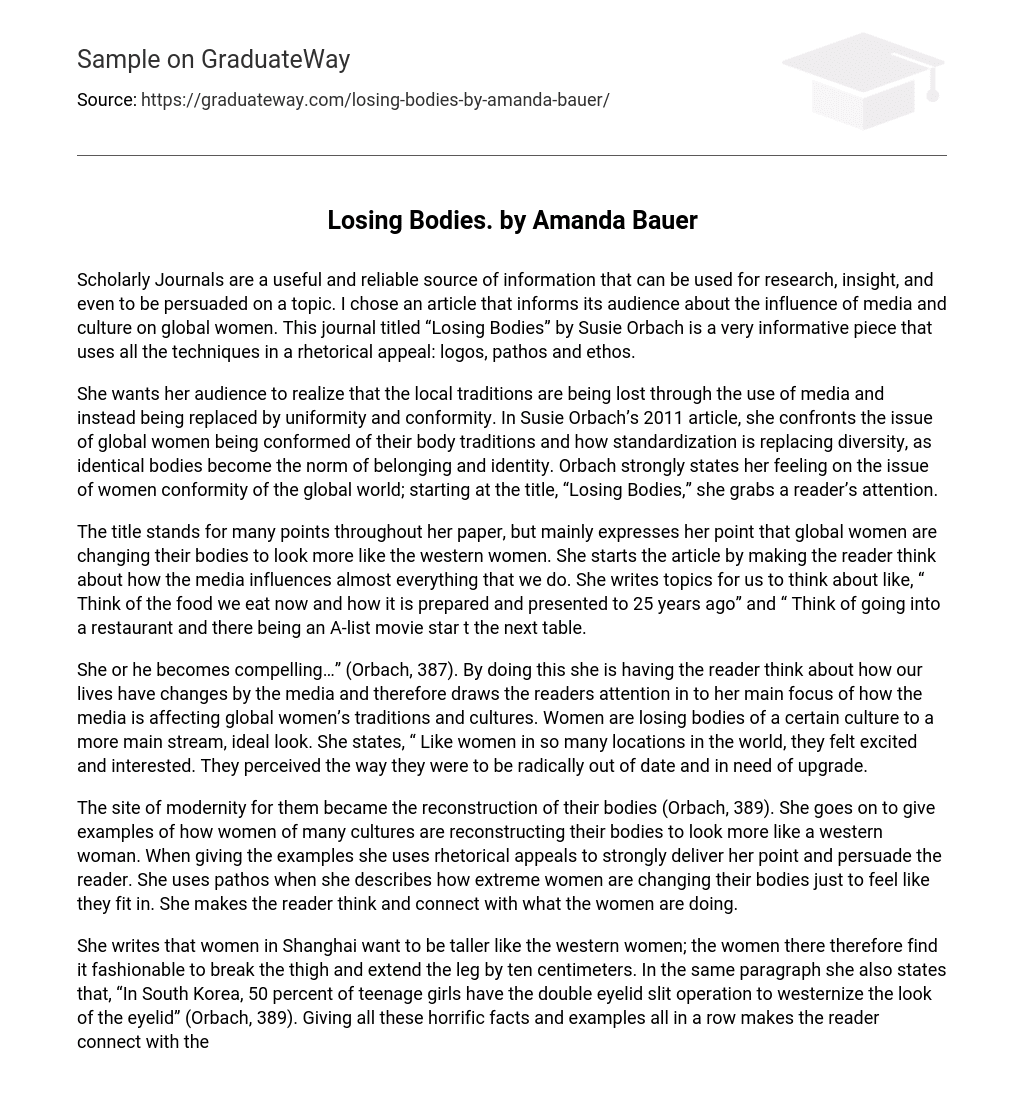Scholarly Journals are a valuable and trustworthy resource for obtaining information, conducting research, gaining insight, and forming opinions on various topics. I have selected an article titled “Losing Bodies” by Susie Orbach, which sheds light on the impact of media and culture on women worldwide. The journal effectively employs the rhetorical appeals of logos, pathos, and ethos to deliver comprehensive and informative content.
In her 2011 article, Susie Orbach emphasizes the loss of local traditions due to the influence of media and the emergence of uniformity and conformity. Specifically, she discusses how global women are conforming to body traditions and how diversity is being replaced by standardization, with identical bodies becoming the norm for belonging and identity. Orbach expresses her strong opinion on this issue throughout the article, starting with the attention-grabbing title, “Losing Bodies.”
The main point of the title is that global women are altering their bodies to resemble western women, although it signifies various aspects throughout the paper. The author initiates the article by prompting readers to contemplate the influential power of media in almost every aspect of our lives. To stimulate our thinking, she presents topics such as the transformation in food preparation and presentation over the past 25 years and encounters with A-list movie stars at restaurants.
In her analysis, Orbach (387) discusses how the media has transformed our lives, making them more compelling. Through this statement, she urges readers to consider the impact of media on global women’s traditions and cultures. One consequence is the loss of traditional bodies as women strive for a more mainstream, ideal appearance. Orbach observes that women in various parts of the world share this sentiment, feeling excited and interested in the need for a radical upgrade due to feeling outdated.
According to Orbach (389), the concept of modernity for certain individuals revolved around the rebuilding of their physical appearances. Orbach further illustrates this idea by presenting instances of women from various cultures modifying their bodies to resemble Western women. In order to effectively convey her argument and convince the reader, she skillfully employs rhetorical appeals. Specifically, by invoking pathos, she highlights the extreme measures some women resort to in order to feel a sense of belonging. Through this approach, Orbach prompts readers to contemplate and empathize with these women’s choices.
According to the author, women in Shanghai desire to be taller like Western women. As a result, they consider it fashionable to undergo thigh-breaking and leg-extension procedures, increasing their height by ten centimeters. Additionally, the author cites that in South Korea, half of the teenage girls opt for double eyelid slit surgery to achieve a Westernized appearance of their eyelids (Orbach, 389). Presenting these distressing facts and examples consecutively captures the reader’s attention and appeals to their emotions. Combining pathos and ethos effectively strengthens the persuasive impact on the reader.
Orbach employs medical facts and emotional persuasion to convey her message effectively. She adopts a formal and informative tone throughout the article, which not only engages the reader but also convinces them to believe in the writer’s message wholeheartedly. By employing the rhetorical appeal of ethos, Orbach establishes herself as a credible and reliable writer, ensuring that the readers trust her words.
In her article, the author provides multiple facts to support her argument. For instance, she mentions that in 1995 Fiji started airing the American show Friends, and by 1998, “11.9 Fijian adolescent girls were over the toilet bowl with bulimia, where previously none existed” (Orbach, 388). By presenting such facts, the author employs various rhetorical appeals. Additionally, she establishes a trustworthy tone, employing ethos. Rather than simply stating that these girls are bulimic, she goes into detail about their actions and emphasizes their young age. This appeals to the reader’s emotions, using pathos as a persuasive technique.
Logos is employed by Susie Orbach in her final paragraph as she presents facts and reasoning to convince the reader. She commences the paragraph by stating, “We are losing bodies as we are losing mother tongues” (Orbach, 394), which serves as a concise summary of her entire article and provokes contemplation. Orbach seeks to persuade the reader to take action against the media’s impact on various cultures and traditions and halt its influence. “Losing Bodies” aims to both persuade and educate readers about how the media is shaping and transforming global cultures and traditions.





